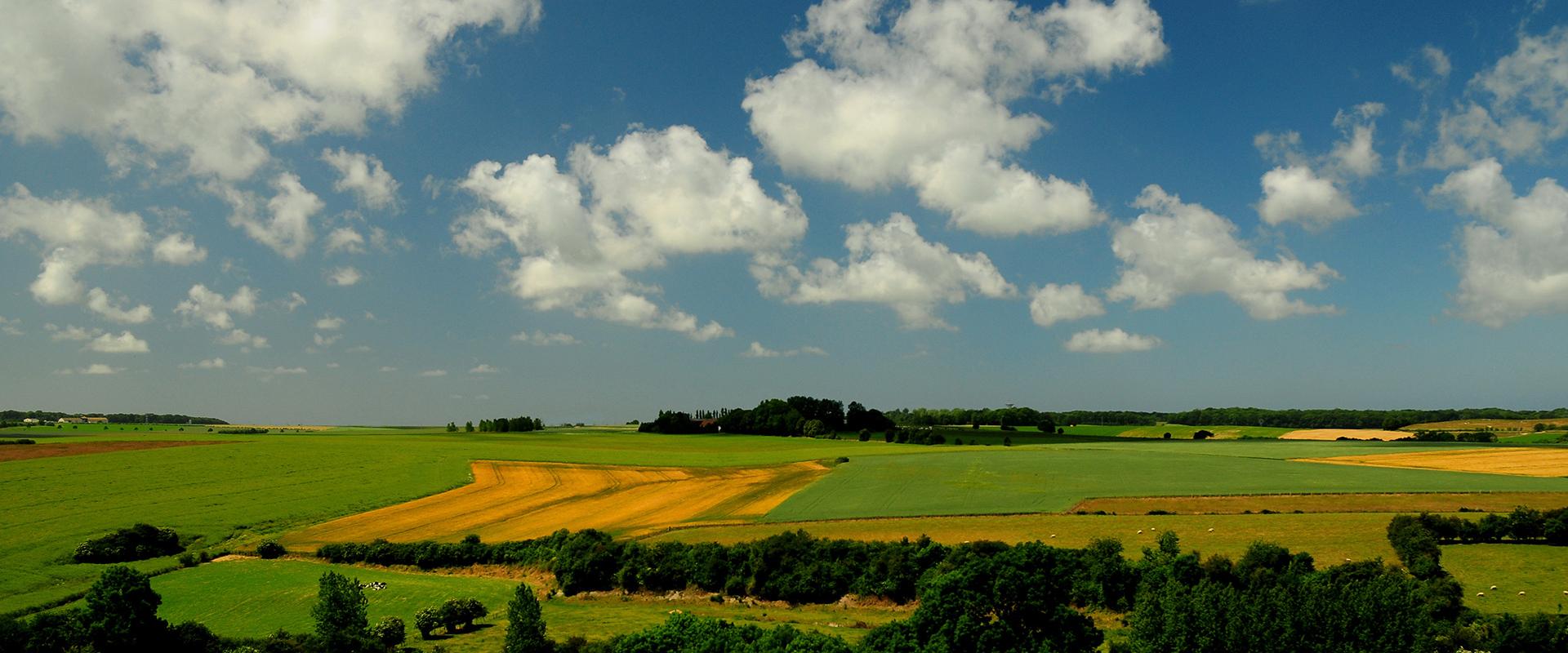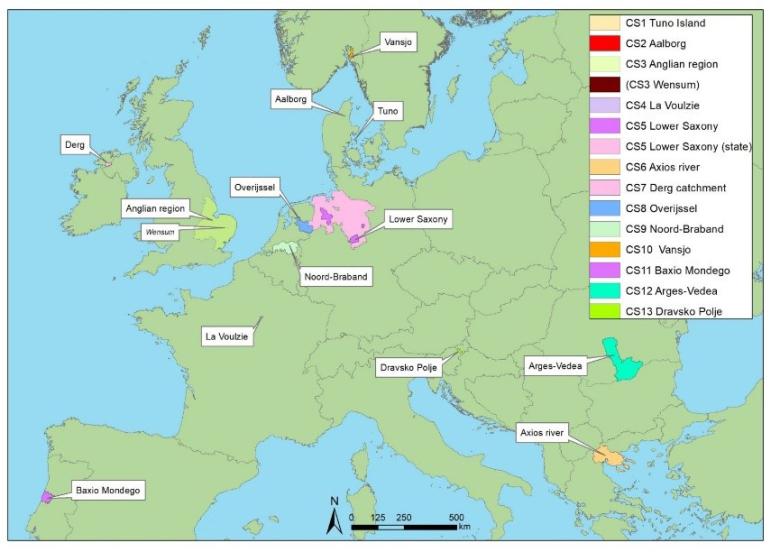Issues and needs
Drinking water is vital for human health. Diffuse nitrogen and pesticide pollution from farming is the main challenge to meeting quality targets for drinking water.
The Fairway project ran from 2017 to 2021. Funded by the European research and innovation programme Horizon 2020, its main objectives were to:
- review existing approaches for protecting drinking water resources from pesticide and nitrate pollution;
- identify and develop innovative measures and governance approaches to protect drinking water more effectively.
Fairway was a European project led by a consortium of 22 partners, including BRGM, in 13 countries.
The project was based on 13 case studies in 11 European Union countries.
Multi-player platforms
Improving nutrient management on a supra-regional scale involves many different players. Information on practical and effective on-farm measures must be communicated by scientists and other players to the decision-makers so that the question can be taken on board and the measures implemented successfully.
Multi-player platforms at regional and local level including farmers, retailers, water companies, research institutes and authorities make an effective contribution to protecting drinking water quality. These multi-player platforms link the different players, increase network connections, transfer knowledge, and improve dialogue, awareness and decision-making on cross-sectoral issues, as well as sparking new developments.
For all the phases of Water Safety Planning, stakeholder participation is essential in developing methodology and content. Establishing cooperation between large and small suppliers helps to overcome barriers to the effective assessment and management of the risks facing small suppliers.
Building and promoting good relations and understanding between players requires long-term commitment, so continuing to facilitate multi-player platforms and to provide financial support is essential to their success.
Monitoring and indicators
- Agricultural nitrogen surpluses are an important, widespread, effective and easy-to-use indicator of nitrate contamination in water. However, any comparison of nitrogen balances calculated across Europe must be interpreted with caution, as methods, data and emission factors vary from one country to another.
- The lag time between changes in farming practice and the response in drinking water quality is an important indicator to be used in a successful drinking water protection strategy. The time required for drinking water protection measures to have an impact on groundwater depends on local hydrogeological conditions, and varies from several years for shallow groundwater to several decades for deeper groundwater.
Farming measures and practices
- A divergence can be observed between the trial-based measures reported in scientific literature and the farm-level (real-world) management option measures applied or reported in case studies.
- Reducing the on-farm pollution of drinking water resources by pesticides requires a combination of measures:
- reducing inputs;
- reviewing farming systems;
- and mitigating point sources.
- The implementation of measures to reduce nitrate losses should take account not only of efficiency and cost, but also of the likelihood of adoption and any possible (undesirable) side effects such as pollution exchanges in the form of atmospheric nitrogen and phosphate emissions.
Decision-support tools
- The main barriers to the exchange of decision-support tools between countries include differences in legislation, usable (statistically validated) data, soil and climate conditions and language. Users prefer to either improve their existing tools or develop new ones specific to their country, rather than trying to modify a decision-support tool designed for another country.
- Support and advice from consultants play an important role in guiding farmers' decisions. Good practices already exist for reducing pesticide use without negatively impacting crop production.
- Decision-support tools are useful for informing farmers on best practices and helping them to plan fertiliser application in order to optimise crop yield and prevent problems relating to the contamination of water by nitrates.
- Many farm management tools promote the intelligent use of nutrients and/or pesticides, but only a few take account of the impact of mitigation methods on water quality.
Governance
A new methodology had to be developed to disentangle the cascade of governance dealing with the agricultural pollution of drinking water resources, from EU directives to national legislation and policy, through to local implementation. The methodology uses a bottom-up approach to involving players. It is useful for identifying anomalies between the understanding and perceptions of local stakeholders and the intentions of policy makers. The method highlights the risk of losing core messages if they are delivered using a top-down approach only. However, although this method is valuable, it can be subjective. Great care should be taken when comparing cascades constructed by different authors.
At local level, farm managers and policy makers can point to many examples of efficient practices based on EU directives, including riparian buffer strips and catch crops (Nitrates Directive) as well as advice, training and trials (Sustainable Pesticides Directive).
A hybrid approach to water quality management is required. This will include i) decentralisation (optional) to ensure collaboration and stakeholder commitment at local level, and ii) a centralised governance system (mandatory) to enable the setting and enforcement of national standards.
The complexities and inconsistencies of EU legislation become more explicit at local level, where cross-sectoral measures need to be taken and their impact monitored. A cross-sectoral approach must be facilitated for policy implementation at local level. This will encourage the emergence of networks between stakeholders, as well as between institutional levels and hydrological scales, in order to achieve greater efficiency.
A mix of mandatory requirements and the active use of subsidies seems to work in many countries. However, further research is needed on the potential conflicts and complexities arising from this combination.
Integration and recommendations at European level
Most obstacles to water quality protection in the European Union are located at national or regional level. They are perceived to reflect a lack of political will, limited knowledge of the process for implementing legislation and a lack of funding options for including scientific know-how in policy development and implementation.
Win-win solutions can be implemented to protect water quality from contamination by plant protection products and nitrates. Solutions for the regulation of plant protection products include biological beds/filters and constructed wetlands. Solutions for nitrate regulation include changing the method of application of organic fertilisers, grassing waterways and changing the cropping and crop rotation system.
BRGM's role
BRGM was the leader of Workpackage 3 "Monitoring and Indicators". In this capacity, it mainly provided expertise in hydrology and the transfer of contaminants (nitrates and plant protection products) to groundwater. As the consortium focused primarily on the agronomic aspects of managing agricultural contamination, BRGM was able to make its expertise available for calculating transfer times and, in particular, identifying long transfer times.
Partners
- Stichting Wageningen Research, Netherlands
- Haskoning dhv Nederland bv, Netherlands
- Wageningen University, Netherlands
- BRGM, France
- Landbrug & Fodevarer f.m.b.a./SEGES, Denmark
- Norsk Institutt for Vannforskning, Norway
- Univerza v Ljubljani, Slovenia
- Fondazione per lo sviluppo sostenibile del mediterraneo, Italy
- CLM Onderzoek en Advies bv, Netherlands
- Johann Heinrich von Thuenen-institut, Bundesforschungsinstitut fuer Laendliche Raeume, Wald und Fischerei, Germany
- Instituto Politecnico de Coimbra, Portugal
- University of Lincoln, United Kingdom
- Institutul National de Cercetare-dezvoltare Pentru Pedologie, Agrochimie si Protectia mediului, Romania
- Aristotelio Panepistimio Thessalonikis, Greece
- Agrifood and Biosciences institute, United Kingdom
- Aarhus Universitet, Denmark
- Geological survey of Denmark and Greenland, Denmark
- Rijksinstituut voor Volksgezondheid en Milieu, Netherlands
- Kmetijsko Gozdarska Zbornika Slovenije Kmetijsko Gozdarski Zavod Maribor, Slovenia
- rsk adas limited, United Kingdom
- Landwirtschaftskammer Niedersachsen, Germany
- Scienceview Media bv, Netherlands
To find out more
Scientific publications
- Matjaž Glavan, Špela Železnikar, Gerard Velthof, Sandra Boekhold, Sindre Langaas and Marina Pintar. 2019. How to Enhance the Role of Science in European Union Policy Making and Implementation: The Case of Agricultural Impacts on Drinking Water Quality. Water 2019, 11(3), 492; OPEN ACESS https://doi.org/10.3390/w11030492
- Klages, S.; Heidecke, C.; Osterburg, B. The Impact of Agricultural Production and Policy on Water Quality during the Dry Year 2018, a Case Study from Germany. Water 2020, 12, 1519. OPEN ACESS https://www.mdpi.com/2073-4441/12/6/1519
- Kim, H.; Surdyk, N.; Møller, I.; Graversgaard, M.; Blicher-Mathiesen, G.; Henriot, A.; Dalgaard, T.; Hansen, B. Lag Time as an Indicator of the Link between Agricultural Pressure and Drinking Water Quality State. Water 2020, 12, 2385. OPEN ACESS :https://doi.org/10.3390/w12092385
- Klages, S.; Heidecke, C.; Osterburg, B.; Bailey, J.; Calciu, I.; Casey, C.; Dalgaard, T.; Frick, H.; Glavan, M.; D’Haene, K.; Hofman, G.; Leitão, I.A.; Surdyk, N.; Verloop, K.; Velthof, G. Nitrogen Surplus—A Unified Indicator for Water Pollution in Europe? Water 2020, 12, 1197. OPEN ACESS https://doi.org/10.3390/w12041197
- Nicholson, F.; Krogshave Laursen, R.; Cassidy, R.; Farrow, L.; Tendler, L.; Williams, J.; Surdyk, N.; Velthof, G. How Can Decision Support Tools Help Reduce Nitrate and Pesticide Pollution from Agriculture? A Literature Review and Practical Insights from the EU FAIRWAY Project. Water 2020, 12, 768. OPEN ACESS https://doi.org/10.3390/w12030768
- S. Wuijts, J. Claessens, L. Farrow, D.G. Doody, S. Klages, C. Christophoridis, R. Cvejić, M. Glavan, I. Nesheim, F. Platjouw, I. Wright, J. Rowbottom, M. Graversgaard, C. van den Brink, I. Leitão, A. Ferreira, S. Boekhold 2021. Protection of drinking water resources from agricultural pressures: Effectiveness of EU regulations in the context of local realities, Journal of Environmental Management, 287:112270 OPEN ACESS https://www.sciencedirect.com/science/article/pii/S0301479721003327








